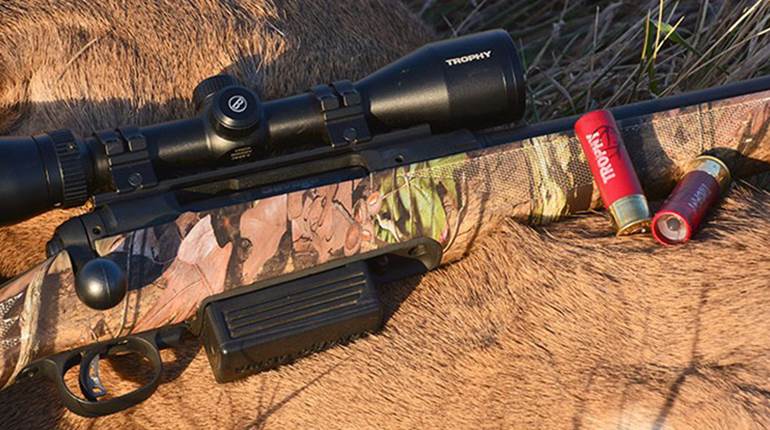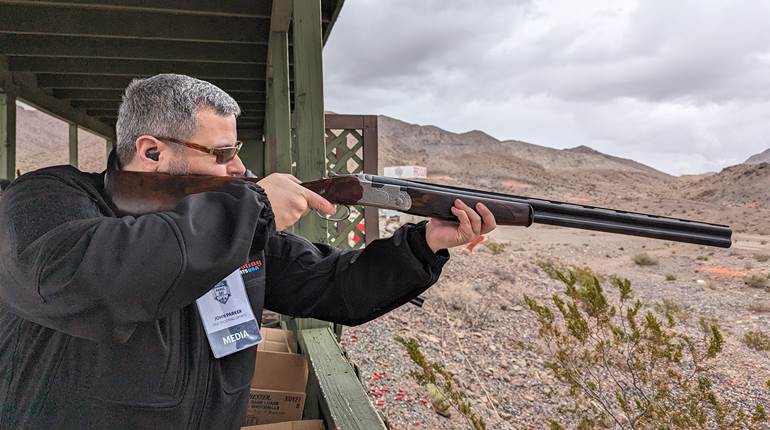
Autumn is a magical season. We get to watch the leaves change colors, feel the brisk air, smell fireplaces start to burn again, and, of course, listen to the argument over turkey chokes. I write this in jes,t but if you poke around just about any online forum or spend your hours in a gun store, you can likely identify with that statement. Every year, folks debate which brands do what to a pattern and some even argue that the brand or style doesn’t matter at all.
After hearing it for about as long as I could stand, I decided it was time to find out for myself. With three different shotguns in hand, I reached out to some popular choke tube manufacturers for samples so that I could conduct a controlled experiment. The shotguns that I decided on were a Browning Maxus II with its 28” barrel, a classic Mossberg 500 with a 28” barrel, and the new Mossberg Pro Field 940, again with a 28” barrel. I wanted to keep barrel length consistent to ensure that my pattern deviation was the result of merely a choke-tube change and nothing more.
Of the tube brands, I chose Carlson, Indian Creek, and Trulock. Each brand sent its most popular models and before I knew it I was swimming in turkey chokes. Trulock was able to send one of its Precision Hunter chokes out for each gun, again keeping things consistent. This style tube is unported, making it a bit quieter (great when shooting from a blind) at the expense of recoil. They also extend the barrel between 0.75" and 1.5", depending on the brand of shotgun it is compatible with.
Indian Creek graced us with its Black Diamond Strike line and was certainly the most attractive of the bunch, with their slotted porting system and full-length knurling. These also extended the barrel, in most cases as much as 2". Carlson was running low on inventory and had to mix and match to get the job done. Nonetheless, they were able to furnish us with a turkey choke tube that would fit each test gun, albeit from two separate lines. Among them were the Bone Collector and the XD, more on that later.

Once all of the chokes arrived, I loaded my range bag with Federal’s Grand Slam ammunition as well as Winchester’s Long Beard XR load, both built with No.5 plated lead shot. I chose these two loads because they represent each company’s most basic turkey fodder and are made to pattern well through a variety of choke tubes. Nearly each tube brand tested has a tube that is built for a specific load and I wanted to do my best to avoid wading in those murky waters.
Consider these shells the pinot noir of the shotgun loads, pairing with almost anything with good results. From a distance of 40 yards, I would fire five test patterns with each gun, with each brand tube, using just one type of ammunition. Next, I would draw a 20" circle around the center of the pattern (wherever it landed), count the number of pellets, and tabulate an average.
Up first was the Browning Maxus II, loaded with the Federal Grand Slam ammunition. I started the test using Carlson’s Bone Collector turkey choke. This choke featured circular porting and added an extra 1.5" to the barrel. Before screwing it in, I measured an inside diameter of 0.665”, making it the middle ground of the three chokes that I would test with this gun. Five shots produced a rather diverse pattern with an average of 183 pellets in my 20” scoring zone.
Although wide, it didn’t appear to have any gaps large enough to miss the average turkey’s head. I repeated the test with the Indian Creek choke and its more constrictive 0.662” diameter, with results showing a minimally decreased saturation average of 174 pellets within the same area. Although there were fewer hits in the ring, the recoil felt significantly lighter, making it a fair trade. Last up was the unported Trulock choke with a measured internal diameter of 0.666”. This choke delivered the most interesting results of the bunch with a whopping 208 pellet average in the scoring ring.

Although the recoil was uncomfortable, there’s a certain comfort in knowing that you are shouldering something with this type of knockdown performance. The next gun that I would test that day would be my old faithful Mossberg 500. With it, I would switch things up and fire off the Winchester XR shells through the three tubes. As a creature of habit, I again started with the Carlson offering, this time from the XD (Xtreme Density) line. With an internal diameter of just 0.658,” it would be the tightest choke that I would test that day and after putting an average of 218 pellets on target, I would understand the argument for more constriction and constriction alone.
However, that feeling of conclusiveness was short-lived as the Trulock choke yielded a significantly higher average pellet count at 255, despite being 0.002” looser and adding the exact same amount of length. I wrapped things up with the 500 by banging five rounds through the Indian Creek Black Diamond Strike choke which had the loosest internal diameter of the three at 0.663”. It generated an average of 231 pellets per scoring ring, again disproving the linear thinking of all that matters is constriction.
My third and final gun was the Mossberg 940, which uses the same chokes as the Mossberg 500. As this gun has the same barrel length as the previous test firearm, I thought it would make the ideal platform to test the significance of ammunition brands through a given choke. Although both the Winchester and Federal rounds offer the same size and payload weight, each uses a unique system that helps control the pellets' flight. Winchester uses a special adhesive that holds the pellets together longer during flight while Federal uses a buffering material to accomplish the same. Because the composition of each shell is drastically different, manufacturers make specific chokes for each load.
As the scope of this test was to gather general data, I asked each manufacturer to send me what is considered to be its most “universal” choke. Using the Federal Grand Slam ammunition this time I found that things certainly changed. The average through the Carlson choke dropped from 218 down to 188, representing about a 15-percent loss. When using the Trulock choke, I saw my average drop from 255 to 201 representing more than a 20-percent loss.

I ended the day the Indian Creek Choke and found that things stayed just about the same, leaving me with an average of 235 pellets (up from 231) in the ring, demonstrating terrific cross-compatibility with this brand. As I cased up the guns (and rubbed my shoulder) I looked over all of the data and tried to force a few conclusions. As I scratched my head, I thought back to my early days of cigar smoking and what I used to go through trying to decide what type of flavor and strength a given cigar would have based on its composition and description.
Today, I understand that the only way to know is to take it out of the showcase and smoke it. That is the same conclusion that I’ve reached with choke tubes. At the end of the day, it pays to buy a few different ones for your shotgun and pattern them to see what happens. Having a few around also leaves you with options in case your preferred ammunition isn’t available or your hunting conditions change.
Application is extraordinarily important here as well. If you are going to be hunting somewhere where you’ll likely have a close encounter, it is going to pay to use the choke that gave you the looser pattern. Whereas if you are sure that a long-range poke is in your future you may just want to screw in that noose of a choke tube to be sure that you can reach out. Features like porting and the amount of extension each choke offer ought to come into consideration as well, as something as silly as 2" can affect your swing in a tight blind and that porting can become equally obnoxious in the same scenario.
The final word is that there is a choke for you out there, just be sure to do your homework and don’t shy away from a field trip either.






































